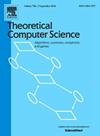On 1-planar graphs with bounded cop-number
IF 0.9
4区 计算机科学
Q3 COMPUTER SCIENCE, THEORY & METHODS
引用次数: 0
Abstract
Cops and Robbers is a type of pursuit-evasion game played on a graph where a set of cops try to capture a single robber. The cops first choose their initial vertex positions, and later the robber chooses a vertex. The cops and robbers make their moves in alternate turns: in the cops' turn, every cop can either choose to move to an adjacent vertex or stay on the same vertex, and likewise the robber in his turn. If the cops can capture the robber in a finite number of rounds, the cops win, otherwise the robber wins. The cop-number of a graph is the minimum number of cops required to catch a robber in the graph. It has long been known that graphs embedded on surfaces (such as planar graphs and toroidal graphs) have a small cop-number. Recently, Durocher et al. [21] investigated the problem of cop-number for the class of 1-planar graphs, which are graphs that can be embedded in the plane such that each edge is crossed at most once. They showed that unlike planar graphs which require just three cops, 1-planar graphs have an unbounded cop-number. On the positive side, they showed that maximal 1-planar graphs require only three cops by crucially using the fact that the endpoints of every crossing in an embedded maximal 1-planar graph induce a . In this paper, we show that the cop-number remains bounded even under the relaxed condition that the endpoints induce at least three edges. More precisely, let an ×-crossing of an embedded 1-planar graph be a crossing whose endpoints induce a matching; i.e., there is no edge connecting the endpoints apart from the crossing edges themselves. We show that any 1-planar graph that can be embedded without ×-crossings has cop-number at most 21. Moreover, any 1-planar graph that can be embedded with at most γ ×-crossings has cop-number at most .
警察与强盗》是一种在图形上进行的追捕-逃避游戏,一组警察试图抓住一个强盗。警察首先选择他们的初始顶点位置,然后劫匪选择一个顶点。警察和劫匪轮流移动:在警察的回合中,每个警察都可以选择移动到相邻的顶点或留在同一个顶点上,同样,劫匪也可以在他的回合中选择移动到相邻的顶点。如果警察能在有限的回合数内抓住劫匪,则警察获胜,否则劫匪获胜。图形的警察数是指在图形中抓捕劫匪所需的最少警察数。众所周知,嵌在曲面上的图形(如平面图形和环面图形)的 cop 数很小。最近,Durocher 等人[21] 研究了 1-planar graphs 类的 cop-number 问题,1-planar graphs 是可以嵌入平面的图,使得每条边最多被交叉一次。他们的研究表明,与只需要三个 cop 的平面图不同,1-平面图的 cop 数是无界的。从积极的方面看,他们利用嵌入的最大 1-planar 图中每次交叉的端点都会诱发 K4 这一关键事实,证明了最大 1-planar 图只需要三个警察。在本文中,我们证明了即使在端点诱导至少三条边的宽松条件下,cop 数仍然是有界的。更确切地说,让嵌入式 1-planar 图的×交叉点成为其端点诱导匹配的交叉点;也就是说,除了交叉点边缘本身之外,没有连接端点的边缘。我们证明,任何可以嵌入而没有 × 交点的 1-planar 图的 cop-number 最多为 21。此外,任何可以嵌入最多 γ ×交叉点的 1-planar 图形的 cop-number 最多为 γ+21。
本文章由计算机程序翻译,如有差异,请以英文原文为准。
求助全文
约1分钟内获得全文
求助全文
来源期刊

Theoretical Computer Science
工程技术-计算机:理论方法
CiteScore
2.60
自引率
18.20%
发文量
471
审稿时长
12.6 months
期刊介绍:
Theoretical Computer Science is mathematical and abstract in spirit, but it derives its motivation from practical and everyday computation. Its aim is to understand the nature of computation and, as a consequence of this understanding, provide more efficient methodologies. All papers introducing or studying mathematical, logic and formal concepts and methods are welcome, provided that their motivation is clearly drawn from the field of computing.
 求助内容:
求助内容: 应助结果提醒方式:
应助结果提醒方式:


